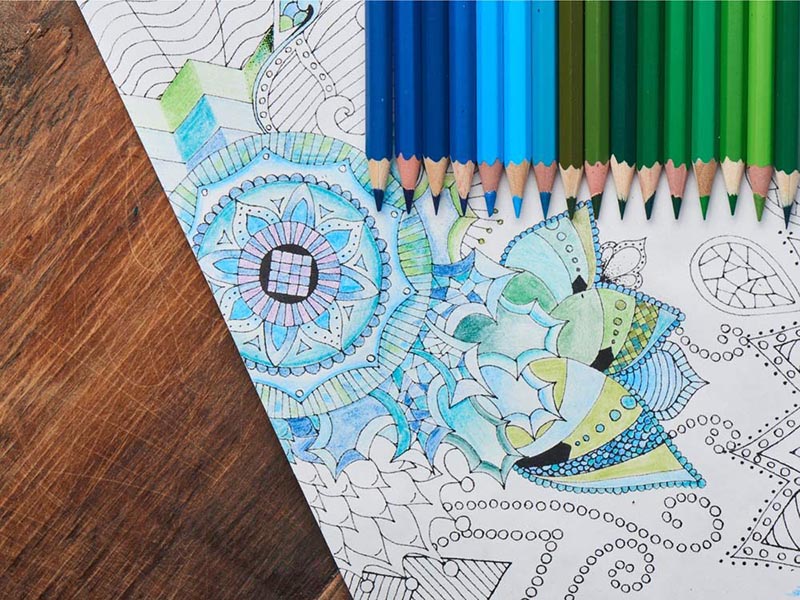
ADHD afflicts a staggering number of adolescents in the US today, and there is a worrying growth in the number of young children being diagnosed with ADD or ADHD every year. Lots of adults also report struggling with symptoms of ADHD throughout their 20s; even if they do not have full-blown ADHD, they find they struggle to focus on complicated or boring tasks for more than 30 minutes, negatively impacting their work.
As you might imagine, many people want to try to combat ADHD symptoms as much as they can without having to rely on powerful ADHD medications and stimulants. This is especially true of young adults who do not have an active ADHD diagnosis but who still struggle with lack of attention, compulsive behaviors and fidgeting.
Thankfully, there are a number of therapeutic techniques you can employ to reduce the symptoms of ADHD, promote concentration, and keep your mind both calm and focused on your work. One of these techniques is art therapy.
Art therapy has been found to be highly effective in reducing the severity of ADHD symptoms, both in those with ADHD diagnoses and those who simply struggle with many of its worst symptoms. In particular, drawing appears to be great for attenuating symptoms of ADD/ADHD in children, adolescents and adults alike.
In this article, we’re going to look at how drawing might help those struggling with ADHD. We will discuss the mechanisms by which drawing helps reduce ADHD symptoms, as well as ways you can employ drawing in your day-to-day routine to keep ADHD symptoms at bay. If you have any personal experience using any form of art therapy to combat ADHD, please share it in the comments section at the end.
Can doodling help with ADHD?
One roadblock to success in the classroom is lack of confidence, but there are ways to encourage creativity. Art can provide a way for students to express themselves in non-competitive ways. By breaking down the art process into small tasks, students can increase the amount of time they spend working on each project. This can be helpful for students with ADHD who may find other outlets for frustration and stress. In addition, it can be a great way to build self-esteem and encourage creativity.
Drawing has been shown to improve attention skills. Doodling can also improve focus. Children with attention deficit disorder can learn to focus their attention by focusing on an image. Drawing can improve concentration and reduce anxiety, and drawing can help them learn to focus their attention. During a pandemic, older children can feel increased stress levels, so they can express their feelings through art. Adults can also benefit from telehealth sessions.
Art therapy for children with ADHD can be beneficial in many ways. It can help children learn to relax, gain self-awareness, and connect with other people. Children with ADHD can benefit from unstructured time to express their creative sides. They will feel better about themselves, which will improve their self-esteem and reduce frustration. And it’s fun! So can drawing help with ADHD? And who doesn’t want to feel more creative?
Does drawing improve focus in kids with ADHD?
The benefits of art projects for children with ADHD are many. Not only do art projects help kids express themselves, they also stretch their imaginations. Kids with attention deficit hyperactivity disorder can benefit from expressive arts therapy, which strengthens focus, problem-solving skills, and builds self-awareness. These benefits are complemented by the fact that children with ADHD benefit from scribbling and other creative activities.
One study looked at the neurobiology of this activity, and found that drawing improved focus and attention in children with attention deficit hyperactivity disorder (ADHD). While this test was not specific to ADHD, it was useful for people with general attention deficit hyperactivity disorder. The researchers studied a group of children with attention deficit hyperactivity disorder (ADHD) and compared their drawing scores with those of typically developing children. In both groups, the children who performed better in the drawing tests had higher levels of dopamine than the typically developing children.
Some research indicates that children with ADHD are more likely to get stressed out than other kids. This may be because they are more easily distracted by their surroundings and have a less active inner critic. Drawing can help channel this energy through other activities, like painting, playing video games, and making up stories. It’s also helpful for adults with ADHD, since it helps them focus during stressful situations. So, it’s a win-win situation for both parties.
How does drawing help with ADHD?
One of the biggest roadblocks that ADHD kids face is a lack of confidence. Drawing provides a noncompetitive outlet for this frustration. It can be a therapeutic way to work through anger and frustration. Another benefit of art therapy is that it can be used by other family members, including ADD parents. For many ADHD children, it can even be a way to build structure in the home. Drawing is especially beneficial for those children who may not have the time or patience to focus.
Children with ADHD may be encouraged to watch television, surf the internet, or play video games to relax. However, increased screen time is linked to increased ADHD symptoms. Even smart phones are considered screens. Drawing, on the other hand, helps children focus and stay away from problems. Learning new skills can relieve stress, physical pain, and emotional stress. Oil painting is even thought to be a therapeutic technique for ADHD and other disorders. If your child is experiencing the symptoms of ADHD, oil painting might be a good choice.
Despite these benefits, research continues to show that drawing can actually help children with attention deficit disorder. Researchers compared college students with ADHD to peers without ADHD and found that those with ADHD had a higher success rate at developing ideas and concepts. However, it’s important to remember that talent is not the same as artistic ability. Although ADHD does not make a child talented, some experts believe that aspects of ADHD may contribute to thriving creatively.
Does coloring help with ADHD symptoms?

Colors can make kids feel good. Studies show that coloring increases serotonin levels, which are responsible for better emotions. In addition, coloring can reduce stress. ADHD kids have improved attention spans after coloring mandalas, a coloring activity that promotes calmness. The effects of coloring on ADHD children are significant. This article will explain the benefits of coloring for children with ADHD. It will also give parents and professionals an idea of how to incorporate coloring into their child’s daily routine.
While the connection between coloring and ADHD is still controversial, there are several other possible explanations. The standard American diet contains large amounts of processed foods, and this routinely makes children with ADHD more likely to develop the disorder. These processed foods can have chemicals in them that worsen ADHD symptoms. It is also important to limit your child’s intake of artificial food coloring, which has not been proven to have a positive effect on ADHD. If you are concerned that artificial food coloring is the culprit, you should choose a variety of fresh whole foods.
Coloring also helps children with ADHD learn how to express their emotions and build better interpersonal skills. It also reduces stress and helps kids better manage their emotions. As an added benefit, it allows children to improve self-awareness. The study showed that 145 children with ADHD met the criteria for an ICD-10 diagnosis. While ADHD is not curable, there are many strategies you can use to manage the condition. It may become second nature to manage ADHD symptoms.
What activities help with ADHD?
Children with ADHD often thrive on adventure. New experiences help them hold their attention longer. You can arrange a treasure hunt around the house or take a nature hike. You can even make the treasure hunt fun and interesting by dressing up your child in a costume and playing the game. Kids with ADHD often love challenges, so make it an event to look forward to. What activities help with ADHD? becomes a simple question when you know the answer to the questions above.
Regardless of the type of ADHD your child has, it’s crucial to create a schedule for him. This routine will help your child understand what you expect of him. It may include meal times, homework, playtime, and bedtime. Before your child goes to sleep, lay out his or her clothes for the next day. Ensure that his or her school supplies are at the ready as well. By making a routine for your child, he or she will be more likely to follow your instructions.
Some children with ADHD are naturally hyperactive and impulsive, which means they tend to lack attention and follow instructions. Regardless of the severity of the child’s condition, however, there are still many activities that are beneficial to children with ADHD. For example, if your child is hyperactive/impulsive, they may benefit from participating in highly physical sports like swimming. Children with inattentive types may find it more beneficial to engage in creative activities, like painting, building with blocks, or making up stories.
Other natural ways to help with ADHD?
Besides medication, you can also try a variety of herbal medicines to improve focus and concentration. Some of them have been proven to help with ADHD symptoms, but further studies are needed. In addition, herbal medicines may interact with meds, so you should check with your doctor before starting a new regimen. Some essential oils are known to improve mood and focus. However, you should be careful and discuss your options with a doctor before using any essential oil.
Another option is to draw your thoughts. Whether you have a big idea or just a random thought, writing it down is an effective way to keep track of them. Some people even set aside time each day to review their notes. Asking ahead of time for a presentation can help your child stay focused during the lecture. Additionally, writing while listening can help them focus on the speaker’s words. For those who struggle with ADHD, writing while listening is a great way to improve attention.
While medication and professional counseling are popular methods, some individuals find these lifestyle remedies to be more effective. Fortunately, there are many natural ways to help with ADHD. Taking advantage of these remedies will reduce the side effects associated with medication and make managing the condition easier. These methods can be very effective if combined with conventional treatment. You should seek professional advice if you choose a natural treatment for ADHD. These methods are not a replacement for professional care, but they can greatly improve your symptoms.

Brian Johnson is current Editor of Vagarights.com and a long-time writer for VAGA. A former psychologist, Brian is passionate about improving mental health and finding ways to stave off cognitive decline. He is an expert on nootropics, cognitive enhancement and biohacking more broadly. You can see his work on Google scholar.
Leave a Reply